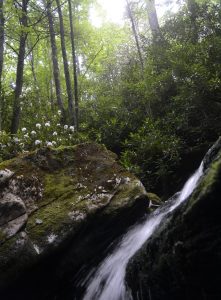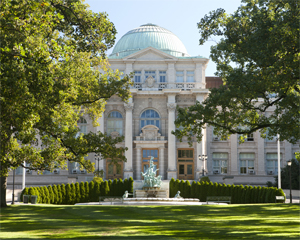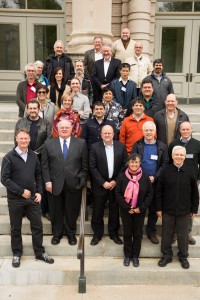Exploring the science of plants, from the field to the lab
Archive: May 2016
Posted in Interesting Plant Stories on May 27, 2016 by Jessica Allen
Jessica L. Allen is studying for a Ph.D. as a student in the Commodore Matthew Perry Graduate Studies Program at The New York Botanical Garden. Lichens are her primary research interest.
 Gnomes exist. They’re quite short and green with black caps. The only place to find them is on rocks in the southern Appalachians, and the best place to find them is in western North Carolina.
Gnomes exist. They’re quite short and green with black caps. The only place to find them is on rocks in the southern Appalachians, and the best place to find them is in western North Carolina.
The gnome I’m describing is actually a lichen (which are combinations of fungi and algae) known as the rock gnome lichen (Cetradonia linearis). It’s one of two fungal species protected by the Endangered Species Act and a member of one of the largest families of lichens, Cladoniaceae.
The rock gnome was one of four fungal species recently added to the Red List, a list of endangered species all over the world that is maintained by the International Union for the Conservation of Nature. Before these four species were added, only two fungal species were recognized on the Red List. The rock gnome lichen was added to the Red List after a successful meeting at The New York Botanical Garden last summer, during which a group of lichenologists came together to prepare detailed assessments of North American lichens.
Read More
Posted in Events on May 16, 2016 by Esther Jackson
Esther Jackson is the Public Services Librarian at NYBG’s LuEsther T. Mertz Library where she manages Reference and Circulation services and oversees the Plant Information Office. She spends much of her time assisting researchers, providing instruction related to library resources, and collaborating with NYBG staff on various projects related to Garden initiatives and events.

On Wednesday, June 15, 2016, from 1 p.m. to 6 p.m., the LuEsther T. Mertz Library will be hosting a Wikipedia Edit-A-Thon focused on creating and sprucing up pages for botanists who have made significant collections in New York State.
Editors are welcome to use the vast historic collections of the Mertz Library to create and edit pages. For those who aren’t familiar with Wikipedia’s editing process, we’ll be offering training to help you get started, and editors of all skill levels are welcome to join in.*
Index Herbariorum and KE EMu, the herbarium collections database at NYBG, were used as starting points to build a list of New York State’s most notable plant collectors. This field has been male-dominated, historically, so we’re making every effort to promote better representation of female botanists. Help us share their contributions with the world!
All you need to do to attend is R.S.V.P. here.
You can view this event on Wikipedia and add yourself to the event page here.
*Attendees must bring a laptop to this event. Please note that training for new editors will be offered during the first hour of this event. New editors should plan on attending this training. Experienced editors are welcome to arrive at any point during this event’s duration.
Posted in Interesting Plant Stories on May 6, 2016 by Stevenson Swanson
Stevenson Swanson is the Science Media Manager at The New York Botanical Garden.
 As if assembling a comprehensive, scientifically verified database of more than 350,000 plant species were not a daunting task to begin with, try doing it in only four years. That’s the ambitious goal the scientists working on World Flora Online (WFO) are racing to meet.
As if assembling a comprehensive, scientifically verified database of more than 350,000 plant species were not a daunting task to begin with, try doing it in only four years. That’s the ambitious goal the scientists working on World Flora Online (WFO) are racing to meet.
When it’s up and running, WFO will provide scientists, conservationists, political leaders, and other policy-makers with information they need to protect one of Earth’s most important resources—its plants.
More than two dozen of the world’s leading plant scientists gathered at The New York Botanical Garden recently to review the progress that has been made on WFO and to plan the way forward so they can meet the goal of completing the database in 2020, which was established in the Convention on Biological Diversity, an international agreement.
As part of a week-long series of meetings at the Botanical Garden, several of the participants spoke about specific aspects of this monumental project during a symposium on Wednesday, April 27, in the Garden’s Ross Hall.
The presentations began with introductory remarks by Barbara M. Thiers, Ph.D., the Garden’s Vice President for Science Administration and the Patricia K. Holmgren Director of the William and Lynda Steere Herbarium. She noted that the Garden is one of four leading botanical institutions that are working together to coordinate the efforts of scientists and institutions around the world to create this first-of-its-kind online resource.
Read More
 Gnomes exist. They’re quite short and green with black caps. The only place to find them is on rocks in the southern Appalachians, and the best place to find them is in western North Carolina.
Gnomes exist. They’re quite short and green with black caps. The only place to find them is on rocks in the southern Appalachians, and the best place to find them is in western North Carolina.

